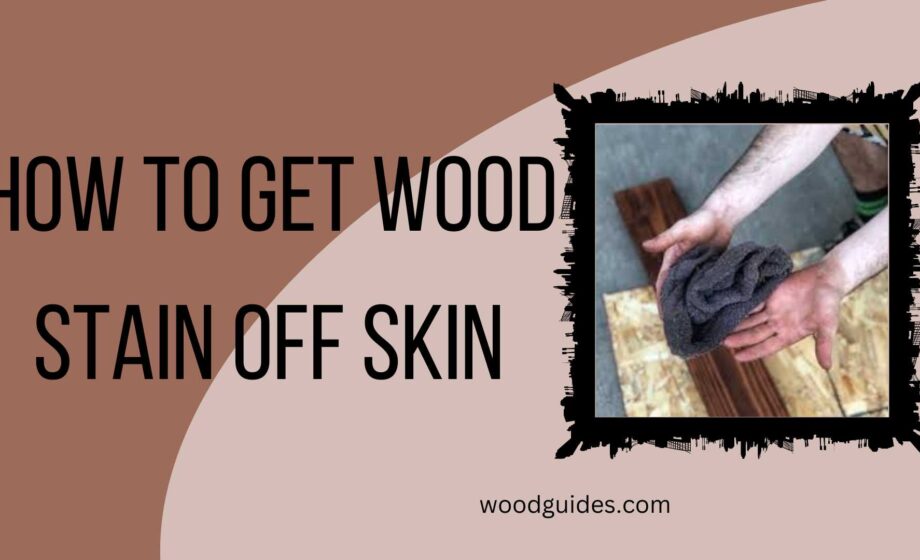Get rid of How to get wood stain off skin on your skin effortlessly with our expert advice. Explore our website for proven techniques and products to restore your skin’s clarity and radiance.
We’ve all been there. You’ve just finished a gratifying day of woodworking or perhaps added a fresh, stylish coat of stain to your tired old furniture, and now your hands look like they’ve been bronzed. Don’t worry – there’s no need to panic. In fact, removing wood stains from your skin is a lot easier than you might imagine. Whether it’s an oil-based or water-based stain, you needn’t fret; we’ve got the solutions, and they are all tried and fully fool-tested proof. Here’s your efficient guide on how to get wood stains off your skin, leaving it clean and unharmed.
“A craftsperson is not measured by the stains on their hands, but by the quality of their work! Here’s to keeping your hands clean and your work impeccable.”
Read on for practical steps and handy tips about how to handle these stubborn stains and reclaiming the natural look of your skin.
Understanding the Nature of How to get wood stain off skin
Wood stain is more than just a colorant used to change the natural hue of wood. It is a solution that can penetrate deep into the wood’s grain, enhancing its texture while offering it a shield from weathering. Different types of stains are available in the market including weathered, clear and semi-transparent stains and they could be removed with tailored chemical strippers like solvent, caustic, or biochemical formulas.
Stain removal, often perceived as a challenging task, is actually a straightforward DIY project. Typically, it involves the application of a chemical stripper to dissolve the finish, followed by scrapping off the loosened stain, and finally sanding down the wood surface to rid it of any remaining stain residue. This process exposes the natural beauty of the wood, asserting an aesthetic appeal that the stain previously overshadowed.
Common wood finishes, including polyurethane, lacquer, shellac, varnish, etc., can effectively be removed using a top-rated deck prep and stain products or an easy-to-use deck stain remover. However, it’s critical to maintain utmost caution while working with these chemical stripping agents.
Safety should always be a priority when working with these substances. They require careful handling, and it’s recommended to work in well-ventilated areas. Wearing protective gloves is a must to prevent skin contact with these potentially harmful chemicals. Wearing a respirator can prevent inhalation of the chemical vapors and particles. Lastly, when dealing with liquid products, eye safety is paramount to prevent accidental splashing into the eyes.
From removing stains, varnishes, dirt, hydration-induced mildew, and mill glaze, a good stain remover works wonders in restoring the beauty of your wooden surface.
Knowing the Risks: Wood Stains on Your Skin
Working with products such as wood stains often requires a level of care and safety. Although getting some of the stains on your skin may not seem like a big deal, it’s always better to prevent it in the first place. Remember, these products usually contain chemicals and solvents designed to penetrate wood, meaning they could potentially have adverse effects on your skin as well.
Increased exposure to wood stain residue, especially chronically, can lead to skin irritation or even more severe issues such as dermatitis. A high level of precaution becomes essential while using wood finishing products. Hence, it would be prudent to equip yourself with appropriate safety gear, such as protective gloves and goggles, especially while working with liquid products prone to splashing. In a worst-case scenario where you get a wood stain on your skin, don’t panic! Many proven techniques and products can help you safely remove the stain. Let’s delve deep into those strategies, but remember, the best preventive measure is to avoid getting it on your skin in the first place.
One common technique involves using chemical strippers, such as solvent, caustic, or biochemical formulas. These agents are designed to remove the finish from wood and work just as well on your skin. But proceed with caution, these chemicals are powerful and can be harsh to the skin.
Why Safe Removal of Wood Stain is Crucial
Alright, let’s dive deeper into why the safe removal of wood stains from your skin is a must. While you’re creating a beautiful DIY masterpiece with wood stain, accidental splashes or spillages on your skin are almost inevitable. The issue here is that wood stain isn’t just a colorant but a compound that heavily influences the nature of the wood it contacts and, by extension, your skin.
Wood stain isn’t like ordinary paint. It soaks into the wood and changes the pigment on a deeper level, which means that it’s excellent at remaining stubbornly in place. We can all appreciate the staying power when it’s enhancing our home’s décor, but it’s a different story when it lands on your skin.
Different wood stains can contain a variety of component types, including solvents, caustic materials, and even bio-chemical formulas, all of which have the potential to irritate or harm your skin if left unchecked. They may cause unwanted reactions, such as redness or itching – especially if you have sensitive skin.
Moreover, many stains and removal products contain volatile organic compounds (VOCs), which can be harmful when inhaled or absorbed through the skin. Consequently, you must follow safety precautions when working with such substances. Ensuring you are in a well-ventilated area is crucial, and donning protective gear such as gloves and eyewear can shield you from direct contact during spillages or splash incidents.
To maintain safety and prevent any long-term damage to the skin, it’s of crucial importance to remove any wood stain from your skin immediately and in a safe manner. By carefully using effective, safe stain removal methods, you protect not only yourself but also the environment around you. Striving for stain removal products with safer ingredients can greatly improve indoor air quality and protect waterways.
Remember, the effective removal of wood stain from your skin doesn’t mean compromising on your health or the environment. In the next sections, we’ll be discussing safe and efficient methods to get this task accomplished. So, read on to find out!
Preparation Before Stain Removal: What You Need
Alright, let’s gear up for this task! Getting How to get wood stain off skin a bit of preparation and some essential items. You don’t want to dive into this without the right setup.
Firstly, ensure that you’re working in a well-ventilated area. This aspect is crucial as it helps disperse the potentially harmful fumes that can emanate from the stain or removing agents that we’ll be using. Fresh air can minimize inhalation risks, keeping you safe throughout the process.
You’ll also need protective gloves to prevent direct skin contact with the wood stain and any chemical stripper involved. This is much needed to safeguard your hands, especially considering some stripers could be solvent or caustic-based. Safety goggles are another key piece of protective equipment; they keep your eyes shielded from splashes that could occur during the stain removal process.
Next, you’ll need a suitable chemical stripper. Notably, there are different types, including solvent, caustic, and biochemical formulas, and each can be effective in its own right. Depending on the type of wood stain on your skin—the level of penetration, the type of dye, etc.—your choice of stripper might vary. For instance, a solvent-based stripper is often effective for removing weathered, clear, and semi-transparent wood stains.
Following the removal process, you’ll need mild soap and water for the cleanup. Washing the affected area can further ensure all traces of the wood stain and the chemical stripper are off your skin, thus returning skin to its natural beauty.
Remember, safety comes first! So, don your protective gear, set up your workspace, and let’s get that wood stain off your skin.
Protecting Your Skin Before Starting a Staining Project
To commence, preparation is always key. Before undertaking any wood staining project, it’s advisable to ensure your skin is protected. It’s not just about aesthetics; your safety and health are on the line, too.
So, how can you keep your skin safe during this process? Start by wearing protective gloves. Chemical-resistant gloves are your best choice, especially when dealing with solvent or caustic chemical strippers.
Moreover, wearing a long-sleeved shirt and pants can minimize skin exposure, and don’t forget the importance of a well-ventilated workspace. This isn’t just for comfort – certain stain removal products can lead to respiratory issues if used in enclosed spaces.
If you’re dealing with a particularly stubborn wood stain, a respirator or protective eyewear might be necessary. Remember, some stain removal products have strong fumes and can splash.
Easy Step-by-step Guide to Removing Wood Stain
When you find yourself stained with a wood finish, there’s no need to panic. With the right approach, you can easily remove this stubborn substance from your skin. Taking the following step-by-step instructions into consideration, we can get you back to your clean skin in no time.
Step 1: Protection First
First and foremost, ensure your safety. If you are still in the workshop or in contact with other wood staining materials, step away from the environment. A well-ventilated area is ideal for handling chemical strippers. Next, protect your eyes and lungs by wearing safety glasses and a respirator, especially if you need to deal with liquid products that may splash. Always remember to wear a pair of protective gloves, even when you’re just dealing with residues. Remember, safety always comes first.
Step 2: Understand the Stain Type
Knowing the type of stain on your skin will direct your removal approach. Is it a simple wood stain colorant, or is it a finish like polyurethane, lacquer, shellac, or varnish? Each type might require a slightly different removal method.
Step 3: Using a Chemical Stripper
If the wood stain is proving tough to remove, consider using a chemical stripper. There’s a range from solvent and caustic, to biochemical formulas. Easy-to-use deck stain removers are also available on the market, and they efficiently remove weathered, clear, and semi-transparent wood stains from your skin. But remember, always use them with care and follow the product’s safety instructions.
Step 4: Application and Removal
Apply the removal agent lightly on the stained area, taking care that it doesn’t spread. Leave the agent on your skin for a few minutes, keeping in mind the advice on the product instructions. Then, gently remove it using a soft cloth or sponge. Most removal agents are formulated to lift away stains, varnishes, dirt, mold, mildew, and mill glaze, restoring the natural beauty of your skin.
Patience is key here, and always remember: it’s better to repeat the process than to aggressively rub the stain and harm your skin! With these easy steps to follow, you are a few moments away from stain-free skin.
Frequently Asked Questions
What does the Safer Choice Label indicate?
Products carrying the Safer Choice label are certified by the U.S. Environmental Protection Agency (EPA). They contain safer ingredients, reducing risks for humans and the environment. These ingredients not only improve indoor air quality but also reduce harm to waterways.
Why should I consider a product’s EPA Certification?
Products certified by the EPA undergo strict testing, ensuring their safety criteria are met. They are evaluated by EPA scientists, providing an independent and trustworthy safeguard. In addition to being safe, these products also meet stringent performance requirements, guaranteeing efficacy.
Can I assess suitable removal products online?
You can absolutely use the R-A-D Product Finder Tool to identify the right product for your specific wood stain removal needs. This tool is especially helpful for locating top-rated deck prep and stain removal products. Furthermore, our Featured Products section showcases items with high customer ratings, providing a reliable starting point.
Can I track my order?
Yes, you certainly can. Our Order Status feature ensures you can track your cleaning or stain removal product order real-time. Keeping you informed and easing stress as you tackle your challenging wood stain removal task.
Conclusion of How to get wood stain off skin
In conclusion, Reword offers a comprehensive platform for users to find the best wood stain removal products that meet their specific needs. With our easy-to-use Product Finder Tool and Featured Products section, you can quickly identify top-rated options for removing stains from your deck or other wooden surfaces. Additionally, our Order Status feature allows you to track your order in real time, providing peace of mind as you embark on your wood stain removal journey. Trust Reword to help you achieve optimal results with guaranteed efficacy and performance requirements.





